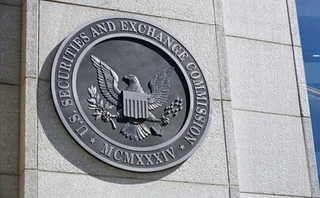Finra clears hurdle with CAT launch, but several others remain
Two major components of the consolidated audit trail are now in place. But wrangling over the CAT’s future continues.

After 14 years of planning, a project to improve transparency and oversight in US markets is finally a reality. The much-awaited second part of the Consolidated Audit Trail went live in May, allowing regulators and market surveillance officials to link specific transaction records stored in the CAT database to the accounts behind each trade.
Although the rollout received little fanfare, the new system marked a significant milestone for the project, according to Howard Meyerson, managing director at the Financial Information Forum, an industry association. “From our perspective, the core of CAT is done. In other words, the development for what CAT was intended to do is completed,” he says.
Monthly data published by the Financial Industry Regulatory Authority (Finra) shows that the CAT is now processing billions of equities and options trades each day, and there are already examples of the data being used to help regulators police markets. But some controversial questions remain over the future of the project—including technical nuances, the funding model, and which data should be added to it over time.
What we have now are a few remaining issues where the regulators are trying to extend CAT further. And these are the areas that are the most costly, that are going to be the most disruptive to market operation, and probably provide the least marginal benefit to the regulators
Howard Meyerson, Financial Information Forum
“What we have now are a few remaining issues where the regulators are trying to extend CAT further. And these are the areas that are the most costly, that are going to be the most disruptive to market operation, and probably provide the least marginal benefit to the regulators,” Meyerson says.
A CAIS of identity
The US Securities and Exchange Commission’s Rule 613, which set the ball rolling for the CAT in 2012, ordered securities exchanges to draw up plans for “a consolidated order tracking system … that would capture customer and order event information for orders in NMS securities.”
To deliver this functionality, the CAT comes in two different parts. The transaction database, which became fully operational in 2021, requires broker-dealers to report the audit trail for options and equities transactions to a central repository. Those broker-dealers provide the customer information associated with each account through the newly launched second component, dubbed the Customer Account Information System (CAIS). This allows regulators to trace transactions back to specific customers at a brokerage using unique customer IDs.
The transaction database has been gradually phased in from 2018, and now covers the majority of the footprint set out by the SEC: domestic and international equities, options, and multi-leg options, including negotiated workflows in the OTC market.
The account information system was originally scheduled to go live in July 2022, but the compliance date was repeatedly delayed to address technical problems with CAIS, including delays in error feedback and processing.
On the last day of this past May, CAIS finally went live. Brokers began submitting information on the customers associated with trades that they were already reporting to the CAT. Smaller firms can submit customer IDs individually on the CAIS portal following transactions, while bigger brokers are more likely to transmit larger files over secure file transfer protocol, with each record in the file representing an account or customer.
FIF’s Meyerson says CAIS is so significant because it allows regulators to look at a single customer’s activity across different broker-dealers for the first time. The Order Audit Trail System (OATS), which the CAT replaced, would show users a snapshot of Broker A’s activity and Broker B’s activity, but it wouldn’t show who held the account making any given trade. “What CAT does now is it shows the regulators the customers, so if they see suspicious activity (let’s say by a customer with one broker), they can look at that customer’s activity across the entire market,” Meyerson explains.
CAT data is already being used by the SEC and by exchanges’ surveillance groups to monitor markets for suspicious activity that could indicate market manipulation, such as front-running or insider trading.
In 2022, the SEC charged an employee at a large asset manager and his associate with operating a front-running scheme. The regulator says that analyzing CAT transaction data helped it to uncover the scheme, which made illegal profits to the tune of $50 million.
In a press release announcing the fraud charges, the head of the SEC Enforcement Division’s market abuse unit underlined the potential of the agency’s new trove of data to contribute to future enforcement cases, saying, “as today’s action shows, SEC staff will utilize data analytics tools at our disposal to find and charge those who engage in illegal trading of securities.”

Finra, which worked with exchanges to develop the project blueprint, says the CAT data is useful for a range of regulatory activities, including market reconstruction and a better understanding of investing trends. But Stephanie Dumont, Finra’s head of market regulation and transparency services, says the biggest use case is market surveillance.
“Finra views audit trail data as essential to our regulatory mission, and CAT data has significantly enhanced our cross-market and cross-product surveillance program coverage—both in terms of scope and precision. Prior to CAT, we had collected nearly all equities activity, but only options execution data. Now, we can—and we do—run cross-market surveillance against 100% of reported equities and options activity,” Dumont says.
Unlike the OATS system that it replaced, CAT records options and equities trades, bringing regulators and exchange surveillance groups a brand new powerful dataset. With the benefit of comprehensive options quote and order data, Dumont says Finra has also been able to develop and deploy new options surveillance patterns covering market abuse areas.
And although regulators use the transaction database—not the CAIS system—to conduct their primary regulatory activities, the addition of IDs can help them spot potentially suspicious patterns by zooming in on individual accounts.
“We can now drill down to the account level on an anonymized basis to better detect and investigate potential fraudulent or manipulative trading activities, as well as filter out potential false positives, making us more effective and efficient,” says Dumont. “It also allows us to better understand new trading and investment patterns, such as overnight trading and zero days to expiration options.”
Job done?
It is not only Finra and the exchanges that have benefited from this project. Gary Gensler, chairman of the SEC, has also been a vocal proponent of CAT. At a hearing before a US Senate committee in June, Gensler was asked to justify his agency’s request for increased federal funding in the coming year. In particular, the Republican committee members called into question the CAT project, raising concerns over its cost, scope, and data security. In response, Gensler emphasized the value of CAT data as a tool to help the SEC effectively police markets.
In addition to the cost of reporting to the CAT, broker-dealers will start receiving their first bills this month in line with plans to transfer two-thirds of the initial construction costs from Finra and exchanges onto broker-dealers.
“We know that CAT has definitely enhanced the SEC’s ability not only to reconstruct market events, like for example the events that happened with the meme stocks (they used CAT data for that). … But it’s also been very helpful in terms of their surveillance efforts, their investigative efforts,” he told senators.
Other market participants have a more complicated relationship with the project. In addition to the cost of reporting to the CAT, broker-dealers will start receiving their first bills this month in line with plans to transfer two-thirds of the initial construction costs from Finra and exchanges onto broker-dealers. And providers of trading platforms have had to build solutions for capturing and reporting transactions executed on their systems.
Douglas Craig, product manager at order management system provider Fidessa (now owned by Ion Markets), says the CAT is an expensive proposition for the industry. “I think we’re probably close to 10,000 developer days invested in this, which is not a resource that would have been allocated had it not been introduced and approved in 2016. We also incurred expense to build out our new production and user acceptance testing (UAT) server farm for nearly 100 customers. Finally, there are direct dollar costs that the industry will bear to compensate Finra for developing and running the CAT,” Craig says.
Fidessa’s approach to CAT reporting was to build its own detailed database that acts as an internal audit trail. As well as building the new server farm, this required sophisticated coding to explain how the trading platform should manifest user actions both as a normalized audit record in the internal database and as part of a CAT report.
Another big challenge was to understand the set of records that the reporting system would have to support, Craig says. As well as capturing orders, the platform needed to parse the CAT symbol master as well as standing data to support account type and the unique IDs assigned to accounts.
Now that the cost of building CAT is being transferred onto broker-dealers, industry associations and market participants are concerned about the difficulty of understanding how CAT bills are calculated and reconciling them with internal records.
“In the US, there’s so much interconnectedness among the exchanges and in the way that an order can travel between market participants,” Craig says. “It could go from a retail broker system onto a Fidessa system run by one of our broker-dealer customers, then to an executing wholesaler or to an ATS or exchange. That order just got passed through four different industry members and participants. Tracking that and determining who pays for what can be very challenging.”
There are direct dollar costs that the industry will bear to compensate Finra for developing and running the CAT
Douglas Craig, Fidessa
FIF’s Meyerson agrees that reconciliation could prove difficult due to the number of intermediaries involved in any single trade. “A lot of times brokers get these fees, and then they want to pass them off to an upstream broker or to a customer. Or clearing firms might pass them through to introducing firms, executing firms might pass them off to routing firms. We want to make sure that the data is there in the billing to allow for that reconciliation of the bills,” Meyerson says.
The market’s questions about the CAT do not stop at billing. Although the initial scope of the project has largely been met, a handful of outstanding technical details could see the reporting burden increase further for firms.
Both manual quotes and electronic request-for-quote responses could be reportable in the future, for example. But it is not immediately clear how firms could capture this information. In the case of manual quotes, this might require the large-scale implementation of natural language processing capabilities or else a significant increase in manual reporting in the back-office.
“When you’re talking about 400 billion records a day, trying to report manual events, where you’re going to have to have compliance people maybe listening to phone calls and figuring out what has to be reported … it just doesn’t work,” Meyerson says.
An executive at a communications technology vendor agreed that designing a system to report every manual trade in the options market appears “neither practical nor necessary,” adding that OTC markets are driven by bespoke trades and private conversations, and attempting to standardize them would be a risk.
Another unresolved detail concerns the requirement for broker-dealers to include exchanges’ port settings in their CAT reports. When a firm routes an order to an exchange, the venue will add certain parameters onto the firm’s original instructions. As it stands, the exchange—but not the routing firm—must report those details to CAT.
We need to give them tools to do their job. Ideally, we do it at a pretty reasonable price with some efficiencies and without undue risk. But that’s complicated
Head of electronic trading at a tier-one North American bank
As of January, broker-dealers will also have to include the exchange’s port settings in their transaction reporting. FIF has filed for exemptive relief for this requirement, arguing that a venue’s port settings do not result from actions taken by the routing firm, so asking firms to report them is not in line with the SEC’s original template for CAT.
Meyerson says that because each venue applies port settings differently depending on the characteristics of an order, it would be hard for broker-dealers to source that information and then report it to CAT. “I think you would have to have some type of new major communications process that would be almost its own mini-CAT, where all the exchanges would have to send out instructions to every routing firm based on order characteristics and which additional instructions the exchanges are applying based on those order characteristics,” Meyerson says. “Then the routing firm is going to have to take those and translate them into CAT instructions. … It’s going to be an insane project—that’s what we’re trying to avoid.”
Those pushing against further expansion of the audit trail say that the project has already given US regulators more data than any other market authorities in the world. But a head of electronic trading at a tier-one North American bank argues that regulators are within their rights in asking for new datasets. For them, the debates unleashed by these demands for ever more visibility are a necessary stage on the path to a compromise between markets and authorities. “We need to give them tools to do their job,” they say. “Ideally, we do it at a pretty reasonable price with some efficiencies and without undue risk. But that’s complicated.”
Further reading
Only users who have a paid subscription or are part of a corporate subscription are able to print or copy content.
To access these options, along with all other subscription benefits, please contact info@waterstechnology.com or view our subscription options here: http://subscriptions.waterstechnology.com/subscribe
You are currently unable to print this content. Please contact info@waterstechnology.com to find out more.
You are currently unable to copy this content. Please contact info@waterstechnology.com to find out more.
Copyright Infopro Digital Limited. All rights reserved.
As outlined in our terms and conditions, https://www.infopro-digital.com/terms-and-conditions/subscriptions/ (point 2.4), printing is limited to a single copy.
If you would like to purchase additional rights please email info@waterstechnology.com
Copyright Infopro Digital Limited. All rights reserved.
You may share this content using our article tools. As outlined in our terms and conditions, https://www.infopro-digital.com/terms-and-conditions/subscriptions/ (clause 2.4), an Authorised User may only make one copy of the materials for their own personal use. You must also comply with the restrictions in clause 2.5.
If you would like to purchase additional rights please email info@waterstechnology.com
More on Regulation
Off-channel messaging (and regulators) still a massive headache for banks
Waters Wrap: Anthony wonders why US regulators are waging a war using fines, while European regulators have chosen a less draconian path.
Banks fret over vendor contracts as Dora deadline looms
Thousands of vendor contracts will need repapering to comply with EU’s new digital resilience rules
Chevron’s absence leaves questions for elusive AI regulation in US
The US Supreme Court’s decision to overturn the Chevron deference presents unique considerations for potential AI rules.
Aussie asset managers struggle to meet ‘bank-like’ collateral, margin obligations
New margin and collateral requirements imposed by UMR and its regulator, Apra, are forcing buy-side firms to find tools to help.
The costly sanctions risks hiding in your supply chain
In an age of geopolitical instability and rising fines, financial firms need to dig deep into the securities they invest in and the issuing company’s network of suppliers and associates.
Industry associations say ECB cloud guidelines clash with EU’s Dora
Responses from industry participants on the European Central Bank’s guidelines are expected in the coming weeks.
Regulators recommend Figi over Cusip, Isin for reporting in FDTA proposal
Another contentious battle in the world of identifiers pits the Figi against Cusip and the Isin, with regulators including the Fed, the SEC, and the CFTC so far backing the Figi.
US Supreme Court clips SEC’s wings with recent rulings
The Supreme Court made a host of decisions at the start of July that spell trouble for regulators—including the SEC.








